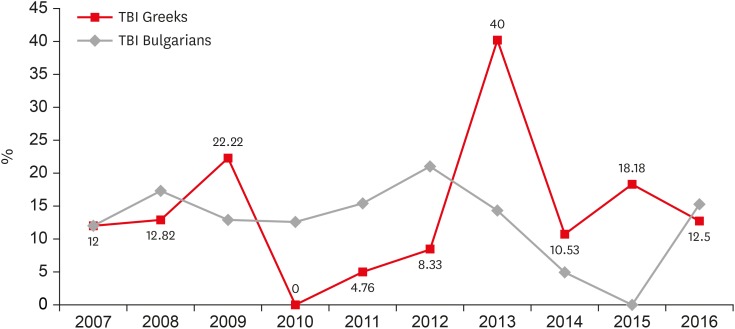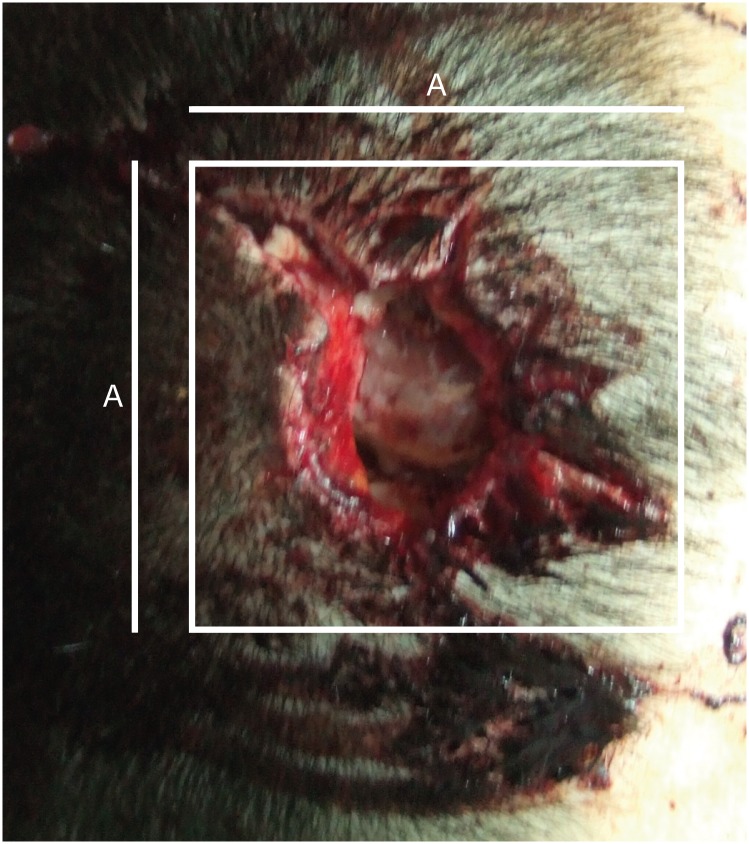Korean J Neurotrauma.
2019 Oct;15(2):95-102. 10.13004/kjnt.2019.15.e34.
Does Nationality Matter for the Gunshot Brain Injury? Ten-Year Retrospective Observational Cadaveric Comparative Study for Gunshot TBI between Greece and Bulgaria
- Affiliations
-
- 1Department of Neurosurgery, Democritus University of Thrace, Alexandroupolis, Greece. nikovaalex@gmail.com
- 2Department of Forensic Science and Toxicology, Democritus University of Thrace, Alexandroupolis, Greece.
- 3Department of Forensic Science and Toxicology, “Stamen Iliev†Regional Hospital, Montana, Bugaria.
- KMID: 2461113
- DOI: http://doi.org/10.13004/kjnt.2019.15.e34
Abstract
OBJECTIVE
Penetrating brain trauma (PBT) caused by gunshot is one of the most lethal traumatic brain injuries (TBIs) and its management and confrontation is of great importance.
METHODS
The authors searched retrospectively the archives from 2 similar autonomous laboratories of forensic science and toxicology in the Balkan peninsula for a 10-year period of time and included only fatal penetrating brain injuries.
RESULTS
The study is conducted in 61 cadavers with gunshot PBT. All of the cadavers were victims of suicide attempt. The most common anatomical localization on the skull were the facial bones, followed by skull base, temporal and parietal bone, conducting a trajectory of the gunshot. Additional findings were atherosclerosis of the blood vessels and chronic diseases such as chronic obstructive pulmonary disease, cancer and fatty liver.
CONCLUSION
PBI has a high mortality rate. There are factors and findings from the collected data differing between the 2 aforementioned nations. Either way, better preventative measures, gun control and healthcare system are highly necessary.
MeSH Terms
-
Atherosclerosis
Balkan Peninsula
Blood Vessels
Brain Injuries*
Brain*
Bulgaria*
Cadaver*
Chronic Disease
Delivery of Health Care
Ethnic Groups*
Facial Bones
Fatty Liver
Forensic Sciences
Greece*
Head Injuries, Penetrating
Humans
Mortality
Parietal Bone
Pulmonary Disease, Chronic Obstructive
Retrospective Studies*
Skull
Skull Base
Suicide
Toxicology
Wounds, Gunshot
Figure
Reference
-
1. Andrade AF, Paiva WS, de Oliveira de Amorium RL, Brock RS, Rodrigues JC, Teixeira MJ. Management of gunshot injuries to the head and brain. Rev Chil Neurocir. 2010; 34:39–45.2. Charry JD, Rubiano AM, Puyana JC, Carney N, David Adelson P. Damage control of civilian penetrating brain injuries in environments of low neuro-monitoring resources. Br J Neurosurg. 2016; 30:235–239. PMID: 26469861.
Article3. Esposito DP, Walker JP. Contemporary management of penetrating brain injury. Neurosurg Q. 2009; 19:249–254.
Article4. Herbst J. The history of weapons. Minneapolis, MN: Twenty First Century Books;2005.5. Izci Y, Kayali H, Daneyemez M, Koksel T. Comparison of clinical outcomes between anteroposterior and lateral penetrating craniocerebral gunshot wounds. Emerg Med J. 2005; 22:409–410. PMID: 15911946.
Article6. Kazim SF, Shamim MS, Tahir MZ, Enam SA, Waheed S. Management of penetrating brain injury. J Emerg Trauma Shock. 2011; 4:395–402. PMID: 21887033.
Article7. Liebenberg WA, Demetriades AK, Hankins M, Hardwidge C, Hartzenberg BH. Penetrating civilian craniocerebral gunshot wounds: a protocol of delayed surgery. Neurosurgery. 2005; 57:293–299. PMID: 16094158.
Article8. Lin DJ, Lam FC, Siracuse JJ, Thomas A, Kasper EM. “Time is brain” the Gifford factor - or: Why do some civilian gunshot wounds to the head do unexpectedly well? A case series with outcomes analysis and a management guide. Surg Neurol Int. 2012; 3:98. PMID: 23061014.
Article9. Solmaz I, Kural C, Temiz C, Seçer HI, Düz B, Gönül E, et al. Traumatic brain injury due to gunshot wounds: a single institution's experience with 442 consecutive patients. Turk Neurosurg. 2009; 19:216–223. PMID: 19621284.10. Tien HC, Tremblay LN, Rizoli SB, Gelberg J, Chughtai T, Tikuisis P, et al. Association between alcohol and mortality in patients with severe traumatic head injury. Arch Surg. 2006; 141:1185–1191. PMID: 17178960.
Article11. Turco L, Cornell DL, Phillips B. Penetrating bihemispheric traumatic brain injury: a collective review of gunshot wounds to the head. World Neurosurg. 2017; 104:653–659. PMID: 28532914.
Article
- Full Text Links
- Actions
-
Cited
- CITED
-
- Close
- Share
- Similar articles
-
- A Case Report of Ureteral Injury by Gunshot Wound
- Paraplegia Following Spinal Cord Contusion from an Indirect Gunshot Injury
- A Case of Renocolic Fistula and Intrarenal Aneurysm by Gunshot Wound
- Experience and successful treatment of craniocerebral gunshot injury at a regional trauma center in Korea: a case report and literature review
- A Case Report of Spinal Cord Injury Patient From a High Velocity Gunshot Wound to the Lumbar Spine



